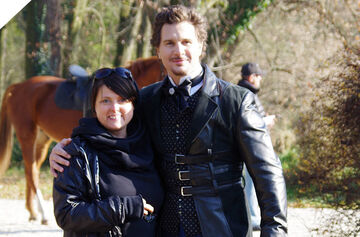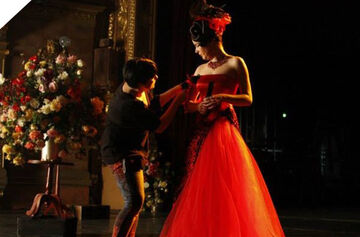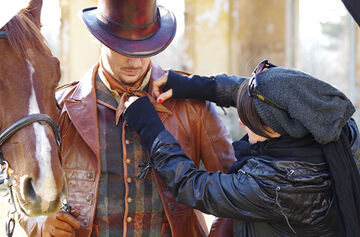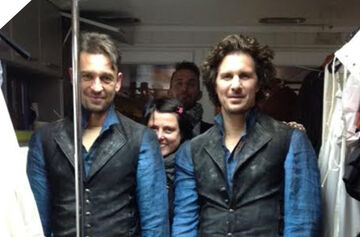The most fantastic thing is when I turn someone into a completely different character
Interview with Ibolya Bárdosi - Hungarian Costume Designer
May 30, 2022
Costume designer and costumer of theatrical plays, commercials and feature films. She has worked in such successful films as Liza, the Fox Fairy, Kincsem and most recently Hands Off My dad! with truly captivating visuals.
"All the world's a stage", really
For as long as she can remember, Ibolya has worked in costumes, even though as a child, she did not even know that such a profession existed. She was born in Szombathely - a small county town near to the western border - and grew up there too, far from the TV and theatre world of Pest, so she didn't have any insight into how this whole world of costumes works. Whenever she could, she would go to the local community centre for guest performances and sit in all the cinemas. She was very interested in the world of costumes, the world of television and movies. "When I was a little girl, I was hiding and sewing patterns from Burda, and as soon as I had an idea in my head, I was sitting next to my grandma's foot-folding Singer sewing machine. Although I never learned how to sew professionally, I liked it, and soon I got a more serious sewing machine, with which I sewed clothes for myself from coloured sheets in the ‘80s. I was pretty extreme at the time in the small town milieu of Szombathely, but I enjoyed it incredibly: I loved that the aunts and uncles living in the house were offended by my appearance, and the provocation went well. I also sewed a pair of pants, the other half of which was a skirt,” Violet recalls the initial momentum. To show her ideas to others and not to use them solely for herself was almost self-evident. The house with the hanging corridor in Szombathely, where she grew up, offered the venue on a tray: already at the age of 8, she arranged a play with the children living in the House. The plaid blanket put on the duster next to the garbage became the stage curtain, which everyone could see from the circular corridor. It was here that the capital-letter MIRACLE happened, as the curtain went up. Ibolya was also the dreamer, inventor and creator of the "performances", and the momentum did not subside for a moment: sets drawn with crayons on wrapping paper, costumes made of rags, and the show could begin! "I didn't care who was watching our shows, it was the very process of creation that captivated me. ” I took it all insanely seriously, and I've been a hardcore perfectionist ever since, " she said. Although her museologist parents enrolled her in a general high school, Ibolya attended drawing classes and art classes there to perfect her drawing skills, including the guidance of Ferenc Massi, graphic artist and painter. After graduation, she graduated from a two-year decorator vocational school, where she developed her drawing technique and acquired a lot of practical skills to flawlessly execute everything she dreamed of. Finally, she graduated from the then College of Applied Arts (today MOME) in 1997 as a clothing designer, graduating with circus costumes.

The sky is the limit
During university, Ibolya got in touch with film director Gábor Herendi, who, after graduation, accepted her as a stylist for Skyfilm, an independent film production team. At first, she took part in the production of commercials, and then came the feature films. Today, everyone knows what the term stylist means, but at that time, the profession was just emerging. Ibolya had to deal with the great experienced hairdressers and make-up artists of the time: they had to accept that they needed a person who would unite the style, who would control it. This was not as clear before as it is now.
Theatre came only after that, relatively late, but she could start right on the biggest stage of the country: the Hungarian State Opera and Géza M. Tóth allowed her to bring Wagner's tetralogy to the stage. Before that, she had only participated in smaller theatre plays (Szkéné Theatre, or Madách Theatre: Seasons). "I'm basically film-minded, but I also love the stage, because there I can use much more vicious forms, even the wildest ideas pass, there aren't many constraints. Wagner's tetralogy was also presented in an amazingly modern way, with futuristic gods and luminous costumes. Even setting up the stage is different from that in the movies. I'm at rehearsals and can have a say in the lighting according to what's best for the costume. In the case of films, this is unthinkable. There, the whole film is given a specific colour afterwards. Sometimes I feel that the colour of the dress is almost lost or that the level has just been turned up on the mixing table, and my previously experimentedcolour combinations have become too vivid. That's what happened at my last job in " Hands Off My Dad!". On the editing board, I can no longer interfere in things” – Ibolya describes the fundamental differences between film and theatre work. In film costumes and small details are also important because there are a lot of close-ups where subtle solutions can be seen. The theatre has a more generous design, larger, more striking forms and a little rougher execution. Although for Ibolya, in the Opera, the fine workings of the clothes are also important, if only because it will be recorded by M5 (one of the national television channels), and everything would be revealed in the TV broadcast.

On the stage of the Hungarian State Opera
Miracle work
"The most fantastic thing in my entire profession is when I turn someone into a completely different character. While reading the scripts, I have visual ideas, which we also discuss with the director. In most cases, they also use my suggestions, " says Ibolya. One of her most memorable memories was in the Hungarian Vagabond when János Greifenstein arrived for a costume rehearsal in a rather flat, moody mood. He was Ond, who was playing a fat, "gobbler" figure. He got a leather costume with a fake belly, then when he put it on, he was completely reborn, he just started talking in a different voice and he immediately had the character down. It was a miracle for those who could follow the transformation. For Ibolya, this is the coolest thing of all: she had the opportunity to conjure a twenty-something valkyrie from a 52-year-old woman, or last time, for example, with "Hands Off My Dad!" to bring out a fat, hunchbacked, old figure from a thin young guy (Máté Járai). She feels that she has great opportunities in her hands. In addition to the transformation, it is also a beautiful and complex task that a given character has to build their wardrobe, depending on the situation, the environment they will be in, with whom they will talk, what clothes are they wearing, what colours will meet exactly there and then in the picture. Each film is a separate universe within which Ibolya builds a set of rules for herself and dresses up her character within that universe. She dresses each character in such a way that she stays within a certain spectrum of colours. Each character has its particular colour and sometimes even form. How much her hands are tied always depends on the director. There are times when they are given complete freedom, for example with Gábor Herendi, there is complete trust between them, and according to her, this is also the success of the films from a costume point of view (Hungarian Vagabond, Kincsem). But unfortunately, she also had an experience where a director's distrust blocked her so much that already hindered her freedom as a designer. In this case, if possible, it is best to leave the project in time because the result will not be as effective as Ibolya would be proud of. Of course, it would be nice to meet all the challenges that arise for the screenwriter, the director, the cameraman and herself, but that is impossible. That is why trust is needed at work. We need to work well with the director, the visual designer, who brings the mood and colours. Then the make-up artist, the hairdresser, to whom Ibolya is already showing the way. However, the closest relationship in films is with the preparatory costume team: the contractor, who calculates the cost of the costumes, gathers the people together and forms them into a team (Lilla Vasvári), or the assistant (Tímea Oláh), the tailor, who cuts out the dreamed designs from sometimes extremely expensive materials (Rita Rémai). An important factor for the team is the dresser (Milán Bredács), who watches the way the costume works in front of the camera and helps the actor to dress and undress, which sounds strange, but it is not only necessary in period films. Each character has their costumes numbered for the scenes, and you have to follow that pretty seriously when it comes to what they're wearing. This position is also a big responsibility. Costumes can be used to create a character very seriously, with greater significance than an outside observer might think. Sometimes the costume helps the character, but if the costume interferes with the actor, it can even work oppositely: "I always try to make the costume help the actor's work, I never force anything on anyone. If they don't feel comfortable in the costume, I prefer to change it,” explains the specialist.

Kincsem - a little last-minute repair
Healthy workaholism
After reading each script, Ibolya digs herself into the given age and mood. Even though she has studied fashion history, she always thoroughly re-studies the given historical style and aligns it with her vision. It harmonizes the character according to the script with its world. She puts together different mood boards with Photoshop, which brings the director closer to the given direction. Then you can start designing, drawing, and material modelling, and suddenly you have what you dreamed of in real life. She designs the characters based on what was written in the script, but there have been screenwriters who have said that the realized costume surpassed everything they imagined. A costume designer probably doesn't need more praise than that. There are times when she runs 2-3 projects in parallel, feature films, commercials and theatre requests, but fortunately, she can keep everything under control. "There are times when I live in the 19th century in my head for months, and then I get pulled out of there, and I have to design futuristic bodysuits. The roller coaster that I can experience through my profession is amazing. If there is a movie, it covers everything in my personal life. We shoot from 4-5 in the morning until midnight. I like being on the set, controlling the costume until the last minute. After all, that's when it gets into place, into the system. I love to see the whole look that it fits into, " says Ibolya about her dedication to her work. In her spare time, she likes to receive guests at her home, cook for them, and conjure the world's cuisine on the table. From sushi to Thai, Chinese, Indian, and Mexican cuisine, she loves and can prepare everything. But she is also working on keeping up with a healthy lifestyle: a meat-free, paleo diet and yoga, which periodically recur in her everyday life. She also watches films in any quantity between two works. For a lucky workaholic, her hobby must also be her job. Otherwise, 12-16 hours of intensive work per day would not work. This – in such quantity and intensity – can only be done out of love. "It's hard to find a balance between work and personal life, but luckily my partner, a fantastic goldsmith and designer, Robert Kuhár, has been working with me on films for years. He is also my faithful companion in most of my films. He is the one who always solves everything in the background.” A long, months-long exotic trip to Bali or Mexico is one of Ibolya's dream plans, but it is always overridden by a much bigger dream (that already came true): costume design. You want to see as much of the world as possible, but you can't plan ahead in this business. At the same time, this is an experience that cannot be exchanged for money, and Ibolya would not change it for anything.
